The Team Group T-Force Cardea (240GB) SSD Review: Grace Under Write Pressure
by Billy Tallis on September 28, 2017 8:00 AM ESTSequential Read Performance
Our first test of sequential read performance uses short bursts of 128MB, issued as 128kB operations with no queuing. The test averages performance across eight bursts for a total of 1GB of data transferred from a drive containing 16GB of data. Between each burst the drive is given enough idle time to keep the overall duty cycle at 20%.
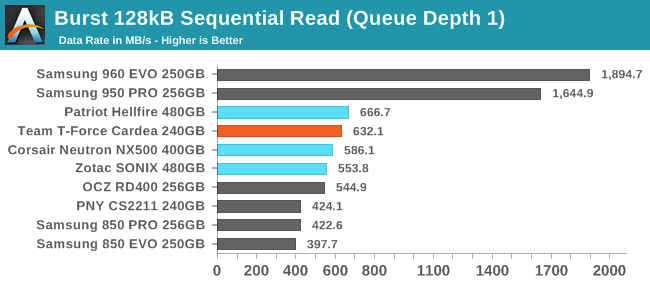
The burst sequential read performance of the Samsung NVMe drives is unmatched, with the 960 EVO about three times faster than the Team T-Force Cardea. It looks like Samsung's drives are quite effective at pre-fetching data in a way the other NVMe SSDs can't.
Our test of sustained sequential reads uses queue depths from 1 to 32, with the performance and power scores computed as the average of QD1, QD2 and QD4. Each queue depth is tested for up to one minute or 32GB transferred, from a drive containing 64GB of data.
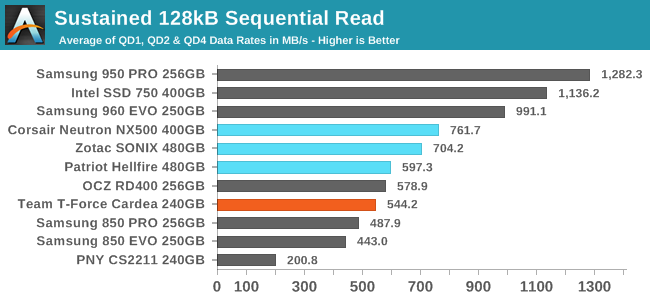
The sustained sequential read performance of the Team T-Force Cardea is lower than the other (larger) Phison E7 drives and all the rest of the NVMe SSDs in this bunch, leaving the Cardea with just a 12% advantage over the fastest SATA SSD.
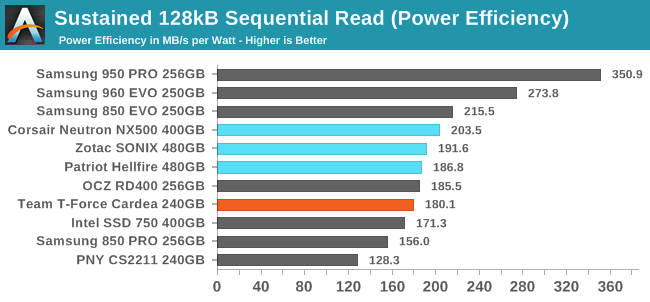
The power efficiency of the T-Force Cardea is also sub-par, but not by quite as large a margin. Samsung as usual is generally at the top, and the larger Phison E7 drives manage somewhat better efficiency than the T-Force Cardea die to their higher performance.
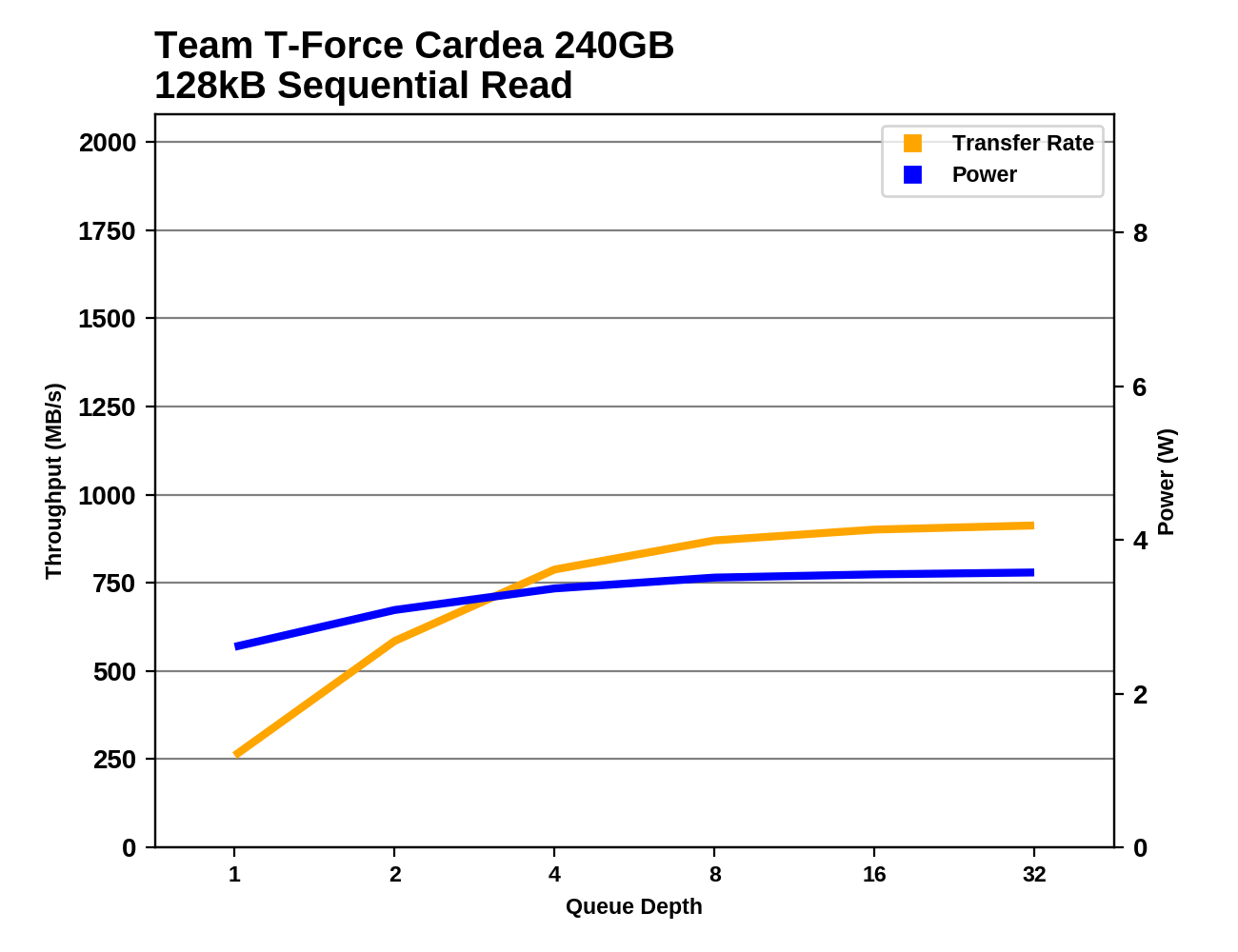 |
|||||||||
The T-Force Cardea takes its time ramping up to full performance on our sustained sequential read test, needing a queue depth of at least 4 to get close to its maximum. That eventual limit is also well below the performance of important competitors like the Samsung 960 EVO.
Sequential Write Performance
Our test of sequential write burst performance is structured identically to the sequential read burst performance test save for the direction of the data transfer. Each burst writes 128MB as 128kB operations issued at QD1, for a total of 1GB of data written to a drive containing 16GB of data.
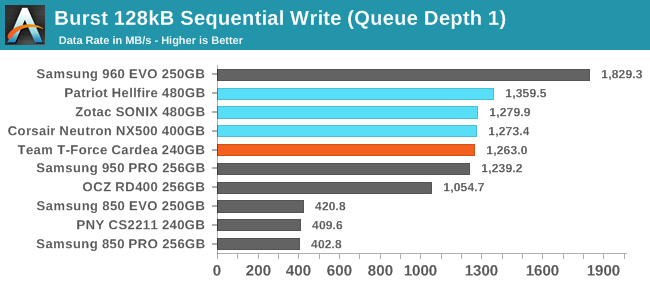
The burst sequential write performance of the Phison E7 drives are all quite close, and second only to the Samsung 960 EVO, albeit by a wide margin.
Our test of sustained sequential writes is structured identically to our sustained sequential read test, save for the direction of the data transfers. Queue depths range from 1 to 32 and each queue depth is tested for up to one minute or 32GB, followed by up to one minute of idle time for the drive to cool off and perform garbage collection. The test is confined to a 64GB span of the drive.
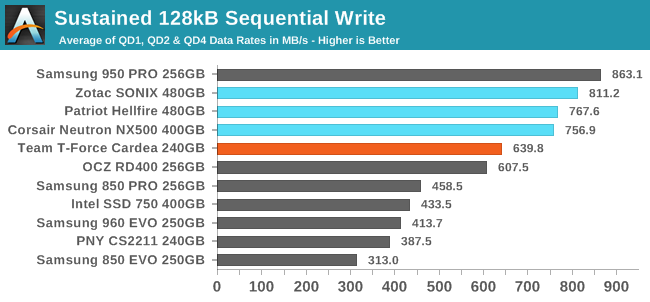
On the sustained sequential write test, the T-Force Cardea's capacity disadvantage comes into play, but it still manages to perform well and beat the Samsung 960 EVO by over 50%.
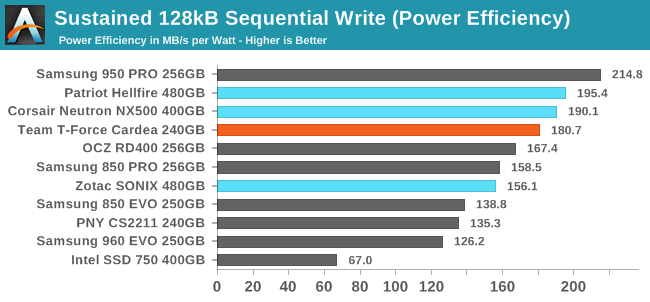
The power efficiency of the T-Force Cardea is good relative to most of its competition, though it is beat by some of the larger Phison E7 drives and by the Samsung 950 PRO.
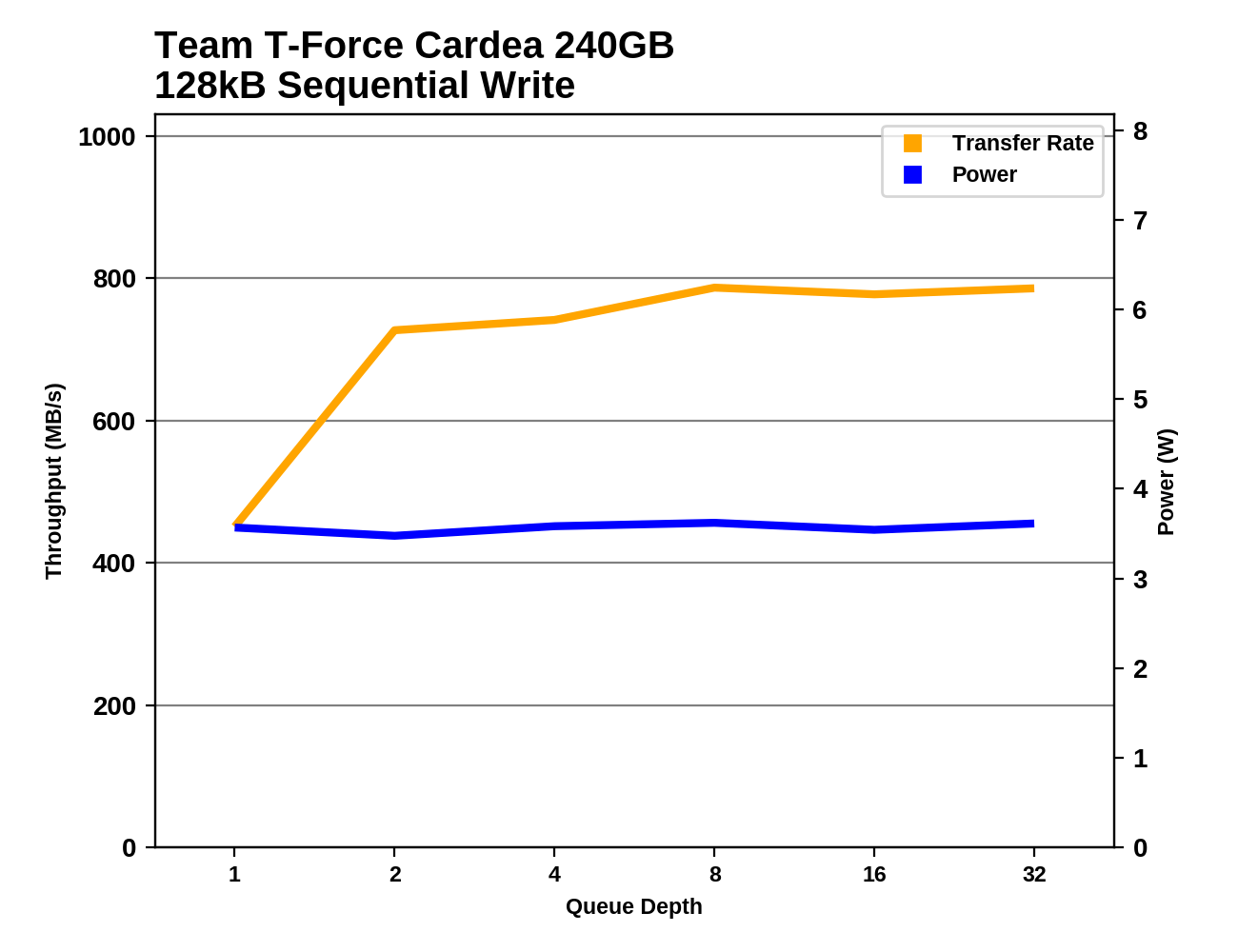 |
|||||||||
The main failing of the Team T-Force Cardea on the sustained sequential write test seems to be at QD1, where the larger Phison E7 drives are already operating close to their full speed. At QD2 or higher, the Cardea is only slightly slower than the other Phison E7 drives.










22 Comments
View All Comments
MajGenRelativity - Thursday, September 28, 2017 - link
While this drive doesn't seem too interesting, I'm very interested in your upcoming review on M.2 Thermal Throttling!Pinn - Thursday, September 28, 2017 - link
You should see it by using ~10G files and a ram drive. The Intel card SSD is much more consistent than the M.2 sticks I've tried.Dr. Swag - Thursday, September 28, 2017 - link
Did you guys change some things? Because it feels like some of the results are different, as I remember the 960 evo doing a lot better before...evilspoons - Thursday, September 28, 2017 - link
These results only include the 250 GB 960 Evo, which is the bottom of the line for the 960 series. IIRC the controller is kneecapped due to having a minimum number of NAND chips available and has no parallel processing ability... hence why reviews like this are interesting!Billy Tallis - Thursday, September 28, 2017 - link
Yep. Our initial review of the 960 EVO only included results from the 1TB model, because our first 250GB sample died during testing. The replacement has been working fine, but its performance profile is very different from the 1TB.The relationship between performance and capacity was the biggest reason I wanted to review this drive; it was the first 240GB Phison E7 sample offered to us.
mapesdhs - Thursday, September 28, 2017 - link
It's shocking how much better than 950 Pro is over the 960 EVO a lot of the time. Other reviews show the EVO has issues with steady state performance even at higher capacities. It's why I bagged a lightly used 950 Pro 512GB recently; noticed someone else no doubt delighted at getting another for 130 UKP BIN. :D And of course, the 950 Pro has its own boot ROM (why the heck did Samsung ditch that? Such a useful feature for older chipsets).CheapSushi - Sunday, October 1, 2017 - link
There's an inherent performance and latency difference between MLC (Pro) and TLC (EVO) NAND. Even with updates, better controllers, etc, it is always there (2 bits per cell vs 3 bits per cell).Dr. Swag - Thursday, September 28, 2017 - link
Ah I see. Interesting to see such a large performance gap, though I guess it makes sense.Gasaraki88 - Thursday, September 28, 2017 - link
I wonder why you guys never reviewed the MyDigitalSSD BPX. It's one of the fastest Phison E7 controller SSDs and the cheapest.DanNeely - Thursday, September 28, 2017 - link
MyDigitalSSD would have to send one in for review...